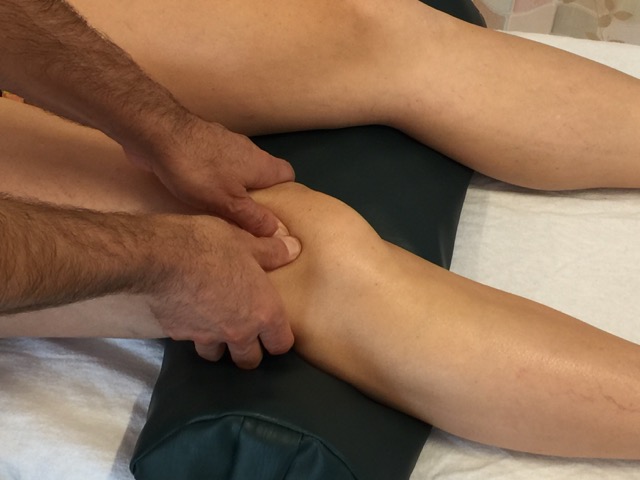Manual therapy treatment:
Manual therapy treatment cannot change the actual degenerative changes of patellofemoral syndrome, however it might be able to affect the causes, thereby stopping or slowing its progression. Given how many possible causes there are, exactly what is done for treatment depends upon the findings of the assessment. If the quadriceps femoris musculature is found to be tight, then clinical orthopedic manual therapy techniques such as heat, soft tissue manipulation, and stretching of the quadriceps are valuable to perform. It is often helpful to also work with deep pressure into the retinacular fibers by working directly along the margins of the patella. The vector for these strokes should be performed circumferentially around the entire patella. As with all deep work, begin with light to medium pressure, and then transition gradually to deeper pressure.
If hip joint adductor or medial rotation musculature is found to be tight, then heat, soft tissue manipulation, and stretching techniques should be directed at these muscles. If TrPs are found in any of the involved musculature, then they should be treated. And, if adhesions or restrictions of motion were found with patellar glide assessment, then joint mobilization should be performed.
To the degree that the cause of the patellofemoral syndrome is weak musculature, such as weak hip joint abductors or lateral rotators, then it is important for the client/patient to strengthen these muscles. If you work with strengthening exercise, recommend the appropriate exercises to the client/patient for self-care, or refer the client/patient to a fitness trainer, physical therapist, yoga or Pilates instructor.
With whatever time is left over, it is important to work the entirety of the lower extremity. The joints of the lower extremity are very interdependent, so if one becomes restricted, then the motion of the others usually decreases too.
Note: Given the many possible causative factors for patellofemoral syndrome, following is a typical treatment that generically addresses the most common factors of patellofemoral syndrome. This treatment approach should be looked at as a guideline and should be changed as appropriate based on the specific assessment findings for your client.
Summary of Manual Therapy Treatment Protocol for Patellofemoral Syndrome (PFS)
| 1. Heat, soft tissue manipulation, and stretching of the quadriceps femoris |
| 2. Deep pressure into the retinacular fibers of the quadriceps femoris |
| 3. Joint mobilization of the patella |
| 4. Heat, soft tissue manipulation, stretching of the hip joint adductor and medial rotation musculature |
| 5. Treat any myofascial trigger points found in the involved musculature |
| 6. Work the entire lower extremity |
| 7. Strengthen (or refer out to strengthen) the weakened/inhibited musculature |
Precautions/contraindications:
There are very few precautions to be aware of when working on the client/patient who has PFS. If stretching of the quadriceps is done, be aware that full flexion of the knee joint might be uncomfortable for the client. If adductor musculature work is done, be aware that the femoral nerve, artery, and vein are located superficial to or nearby the pectineus. And deeper work to the retinacular fibers of the quadriceps femoris might not be possible if inflammation is present in the area.



